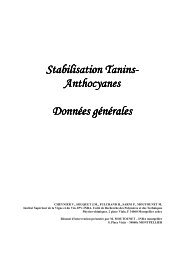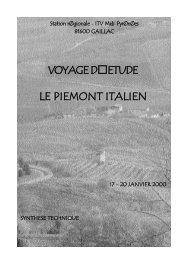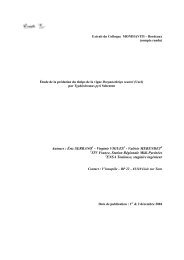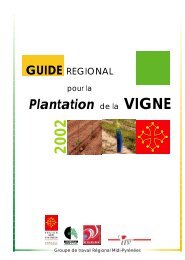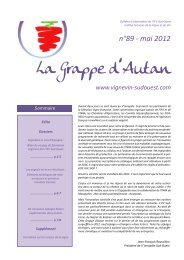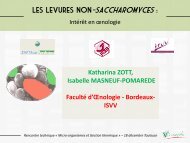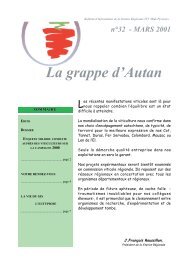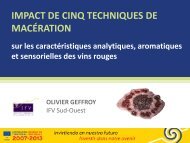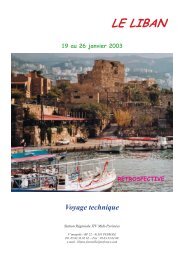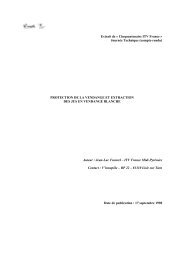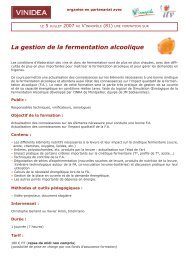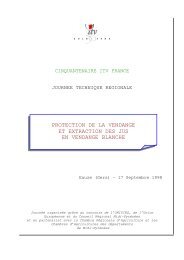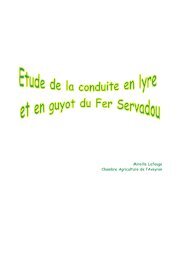Bioconversion de l'acide p-coumarique par Brettanomyces ...
Bioconversion de l'acide p-coumarique par Brettanomyces ...
Bioconversion de l'acide p-coumarique par Brettanomyces ...
You also want an ePaper? Increase the reach of your titles
YUMPU automatically turns print PDFs into web optimized ePapers that Google loves.
Author's personal copyD. Salameh et al. / Food Chemistry 107 (2008) 1661–1667 1663The automatic injector was used in a full loop of 20 ll,with a mobile phase composed of: water 77%, acetonitrile23%. Formic acid was ad<strong>de</strong>d in the concentrationof 0.12 g/l to regulate the pH at 3.5. The flow was fixedat 0.7 ml/min. The <strong>de</strong>tector used was a UV spectrophotometer.The <strong>de</strong>tection was done at 305 nm. p-Coumaricacid retention time was 12.5 min.2.2. Stability tests of the p-coumaric acid with experimentalconditionsIn or<strong>de</strong>r to study the day light and oxygen effect onthe p-coumaric acid in our experimental conditions, two40 mg/l solutions of p-coumaric acid were pre<strong>par</strong>ed inErlenmeyer flasks of 500 ml containing 300 ml of liquid.The first solution was a synthetic wine medium with10% v/v ethanol; the second was a hydroalcoholic solutioncontaining distilled water with 10% v/v ethanol.Both of the solutions were stirred for 10 days at ambienttemperature, closed insi<strong>de</strong> the Erlenmeyer flasks. Eachsolution was monitored by UV spectrophotometry at305 nm.On the other hand, to study the p-coumaric acid thermo<strong>de</strong>gradationat high temperature, two 40 mg/l solutionsof p-coumaric acid dissolved into a synthetic wine mediumwere pre<strong>par</strong>ed into 50 ml volume Pyrex Shott containers.They were kept in darkness without any contact with air.Two temperatures were tested: ambient temperature(approximately 20 °C) and 75 °C obtained using a heatingplate. The changes in absorbance at 305 nm were <strong>de</strong>tectedin time. Absorbance changes of the p-coumaric acid solutionwere equally tested before and after autoclaving for20 min at 120 °C.2.3. Reactivity tests of the p-coumaric acid with mediacomponentsTo study the p-coumaric acid dissolution in ethanol,10 mg/l of the acid were ad<strong>de</strong>d either after being dissolvedor not into ethanol to synthetic wine media containing 10%v/v ethanol. The absorbance of the acid was followed up intime by UV spectrophotometer in quartz cells at 305 nmfor 120 h.On the other hand, p-coumaric acid was either beingad<strong>de</strong>d or not to different media to study its reactivity withethanol as a solvent or with tartaric acid. These differentmedia had the following composition: Medium A (Hydroalcoholic:water/ethanol 10% v/v), Medium B (water–20mg/l of p-coumaric acid), Medium C (pure ethanol–20 mg/l of p-coumaric acid), Medium D (Hydroalcoholic:water/ethanol 10% v/v–20 mg/l of p-coumaric acid), MediumE (synthetic wine medium 10% v/v ethanol), MediumF (synthetic wine medium 10% v/v ethanol–20 mg/l ofp-coumaric acid), Medium G (tartaric acid solution–20 mg/l of p-coumaric acid). The solutions were followedup by UV analysis with a sweeping wavelength between250 and 350 nm.2.4. Nuclear magnetic resonance (NMR) and infra red (IR)analysisTwo solutions of p-coumaric acid were pre<strong>par</strong>ed andtested by NMR to know whether a reaction occurs ornot between p-coumaric acid and tartaric acid or betweenp-coumaric acid and ethanol. The first contained 10 mg/lof p-coumaric acid dissolved in ethanol; the second contained10 mg/l of p-coumaric acid dissolved in tartaric acidsolution. In both solutions, pH was adjusted to 3.5 as inour oenological conditions. The NMR spectrum of thecrystalline p-coumaric pow<strong>de</strong>r was done after dissolutionin DMSO at 10 mg/l concentration in or<strong>de</strong>r to be com<strong>par</strong>edto other spectra. The NMR tests were recor<strong>de</strong>d at300 MHz on a Brucker spectrometer. Chemical shifts areexpressed in <strong>par</strong>t per million relative to tetramethylsilane.NMR solvent was pure DMSO.On the other hand, infra red analysis of the pure p-coumaricacid and the one dissolved into ethanol, where thepH was regulated at 3.5, were acquired on a Shimadzu-8300 Fourier Transform infra red spectrophotometer.2.5. Adsorption test of p-coumaric acid on <strong>Brettanomyces</strong>yeastsOne strain of yeast was isolated from Buzet winery, situatedin the south west of France. It was i<strong>de</strong>ntified geneticallyas <strong>Brettanomyces</strong> bruxellensis. The <strong>Brettanomyces</strong>yeast was scraped from a Petri dish where it was storedat 4 °C.The yeast culture medium was a synthetic wine mediumthat had the following composition: glucose 20 g/l, yeastextract 0.5 g/l, (NH 4 ) 2 SO 4 0.5 g/l, citric acid 0.3 g/l, malicacid 3 g/l, tartaric acid 2 g/l, MgSO 4 0.4 g/l, KH 2 PO 4 5g/l, glycerol 6 g/l. Ethanol was ad<strong>de</strong>d up to 10% v/v afterautoclaving. Culture of <strong>Brettanomyces</strong> was inoculated at3.10 6 cell/ml yeast concentration. Culture was carried outin 500 ml Erlenmeyer flask with 300 ml of liquid mediumstirred at 250 rpm. After inoculation, culture flasks wereincubated at 30 °C.Fermentation was carried out in or<strong>de</strong>r to have differentpopulation concentration of <strong>Brettanomyces</strong> yeast at differentstages of yeast growth.p-Coumaric acid was ad<strong>de</strong>d in the fermentation<strong>de</strong>scribed above after dissolution in 1 ml of pure ethanol,to have respectively the concentration of 5, 10 or 20 mg/l.Two minutes after adding p-coumaric acid in each solution,a sample was taken, centrifuged, and then the liquid <strong>par</strong>twas tested on HPLC to <strong>de</strong>tect the p-coumaric acid concentration,and on GC/MS to <strong>de</strong>tect the vinylphenol and ethylphenolscontent. Three synthetic wine mediums (T1, T2and T3) free of <strong>Brettanomyces</strong> yeast were pre<strong>par</strong>ed containing,respectively, 5, 10 and 20 mg/l of p-coumaric acid and



